物流管理 Logistics Manager
物流行业职业资格证书
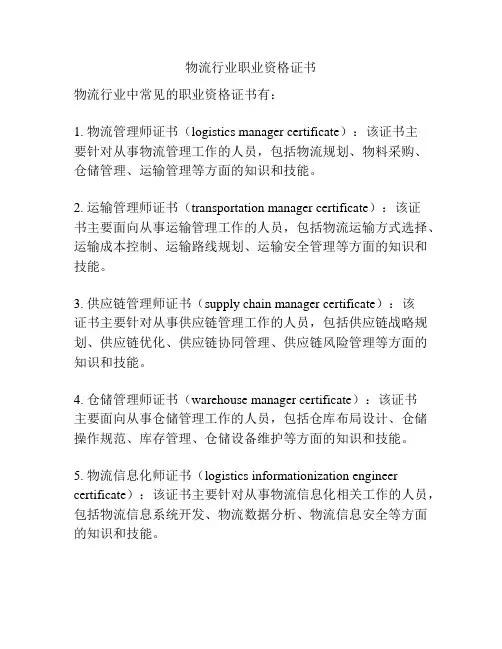
物流行业职业资格证书
物流行业中常见的职业资格证书有:
1. 物流管理师证书(logistics manager certificate):该证书主
要针对从事物流管理工作的人员,包括物流规划、物料采购、仓储管理、运输管理等方面的知识和技能。
2. 运输管理师证书(transportation manager certificate):该证
书主要面向从事运输管理工作的人员,包括物流运输方式选择、运输成本控制、运输路线规划、运输安全管理等方面的知识和技能。
3. 供应链管理师证书(supply chain manager certificate):该
证书主要针对从事供应链管理工作的人员,包括供应链战略规划、供应链优化、供应链协同管理、供应链风险管理等方面的知识和技能。
4. 仓储管理师证书(warehouse manager certificate):该证书
主要面向从事仓储管理工作的人员,包括仓库布局设计、仓储操作规范、库存管理、仓储设备维护等方面的知识和技能。
5. 物流信息化师证书(logistics informationization engineer certificate):该证书主要针对从事物流信息化相关工作的人员,包括物流信息系统开发、物流数据分析、物流信息安全等方面的知识和技能。
这些职业资格证书能够对从事物流行业的人员进行专业能力的认证,提升自身的竞争力和职业发展。
外国贸易商的详细职务说明
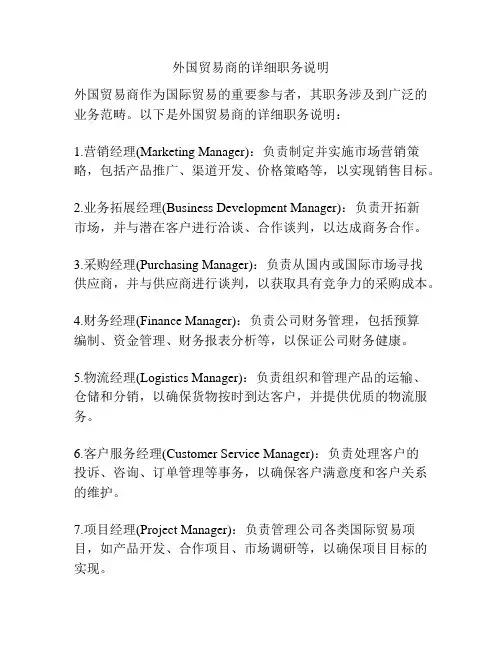
外国贸易商的详细职务说明外国贸易商作为国际贸易的重要参与者,其职务涉及到广泛的业务范畴。
以下是外国贸易商的详细职务说明:1.营销经理(Marketing Manager):负责制定并实施市场营销策略,包括产品推广、渠道开发、价格策略等,以实现销售目标。
2.业务拓展经理(Business Development Manager):负责开拓新市场,并与潜在客户进行洽谈、合作谈判,以达成商务合作。
3.采购经理(Purchasing Manager):负责从国内或国际市场寻找供应商,并与供应商进行谈判,以获取具有竞争力的采购成本。
4.财务经理(Finance Manager):负责公司财务管理,包括预算编制、资金管理、财务报表分析等,以保证公司财务健康。
5.物流经理(Logistics Manager):负责组织和管理产品的运输、仓储和分销,以确保货物按时到达客户,并提供优质的物流服务。
6.客户服务经理(Customer Service Manager):负责处理客户的投诉、咨询、订单管理等事务,以确保客户满意度和客户关系的维护。
7.项目经理(Project Manager):负责管理公司各类国际贸易项目,如产品开发、合作项目、市场调研等,以确保项目目标的实现。
8.国际贸易法律顾问(International Trade Legal Advisor):负责提供法律咨询和意见,确保公司的国际贸易活动合规,并处理相关的法律纠纷。
9.风险管理经理(Risk Management Manager):负责评估与国际贸易相关的风险,并制定风险管理策略,以保护公司的利益和资产。
10.市场研究分析师(Market Research Analyst):负责进行市场调研和数据分析,以了解市场趋势、竞争对手和消费者需求,为决策提供有价值的信息。
11.品牌经理(Brand Manager):负责构建和推广公司的品牌形象,以提升产品的市场认知度和竞争力。
物流管理专用英语

物流管理专用英语 Revised as of 23 November 2020物流管理专用英语这里是物流管理33个专用英语,希望能给大家带来便利!1物品Article经济活动中涉及到实体流动的物质资料。
2物流Logistics物品从供应地向接收地的实体流动过程。
根据实际需要,将运输、储存、装卸、搬运、包装、流通加工、配送、信息处理等基本功能实施的有机结合。
3物流活动Logistics?activity物流诸功能的实施与管理过程。
4物流作业Logistics?operation实现物流功能时所进行的具体*作活动。
5物流模数Logistics?modulus物流设施与设备的尺寸基准。
6物流技术Logistics?technology物流活动中所采用的自然科学与社会科学方面的理论、方法,以及设施、设备、装置与工艺的总称。
7物流成本Logistics?cost物流活动中所消耗的物化劳动和活劳动的货币表现。
8物流管理Logistics?management为了以最低的物流成本达到用户所满意的服务水平,对物流活动进行的计划、组织、协调与控制。
9物流中心Logistics?center从事物流活动的场所或组织。
应基本符合下列要求:(1)主要面向社会服务;(2)物流功能健全;(3)完善的信息网络;(4)辐射范围大;(5)少品种、大批量;(6)存储、吞吐能力强;(7)物流业务统一经营、管理。
10物流网络Logistics?network物流过程中相互联系的组织与设施的集合。
11物流信息Logistics?information反映物流各种活动内容的知识、资料、图象、数据、文件的总称。
12物流企业Logistics?enterprise从事物流活动的经济组织。
13物流单证Logistics?document s物流过程中使用的所有单据、票据、凭证的总称。
14物流联盟Logistics?alliance两个或两个以上的经济组织为实现特定的物流目标而采取的长期联合与合作。
物流管理练习题
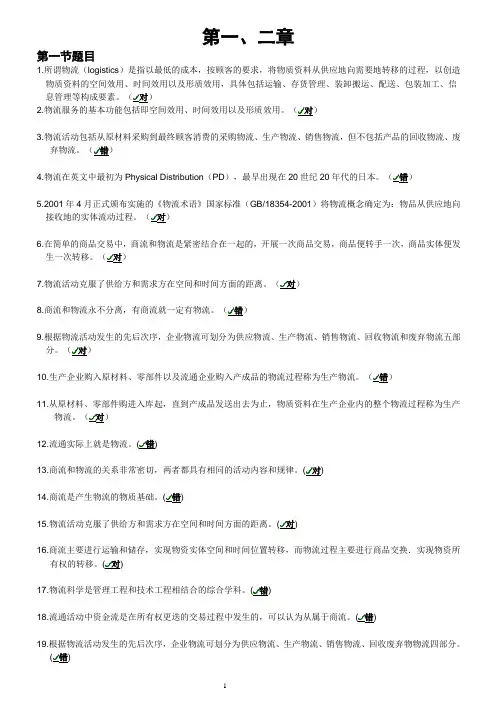
第一、二章第一节题目1.所谓物流(logistics)是指以最低的成本,按顾客的要求,将物质资料从供应地向需要地转移的过程,以创造物质资料的空间效用、时间效用以及形质效用,具体包括运输、存货管理、装卸搬运、配送、包装加工、信息管理等构成要素。
(对)2.物流服务的基本功能包括即空间效用、时间效用以及形质效用。
(对)3.物流活动包括从原材料采购到最终顾客消费的采购物流、生产物流、销售物流,但不包括产品的回收物流、废弃物流。
(错)4.物流在英文中最初为Physical Distribution(PD),最早出现在20世纪20年代的日本。
(错)5.2001年4月正式颁布实施的《物流术语》国家标准(GB/18354-2001)将物流概念确定为:物品从供应地向接收地的实体流动过程。
(对)6.在简单的商品交易中,商流和物流是紧密结合在一起的,开展一次商品交易,商品便转手一次,商品实体便发生一次转移。
(对)7.物流活动克服了供给方和需求方在空间和时间方面的距离。
(对)8.商流和物流永不分离,有商流就一定有物流。
(错)9.根据物流活动发生的先后次序,企业物流可划分为供应物流、生产物流、销售物流、回收物流和废弃物流五部分。
(对)10.生产企业购入原材料、零部件以及流通企业购入产成品的物流过程称为生产物流。
(错)11.从原材料、零部件购进入库起,直到产成品发送出去为止,物质资料在生产企业内的整个物流过程称为生产物流。
(对)12.流通实际上就是物流。
(错)13.商流和物流的关系非常密切,两者都具有相同的活动内容和规律。
(对)14.商流是产生物流的物质基础。
(错)15.物流活动克服了供给方和需求方在空间和时间方面的距离。
(对)16.商流主要进行运输和储存,实现物资实体空间和时间位置转移,而物流过程主要进行商品交换.实现物资所有权的转移。
(对)17.物流科学是管理工程和技术工程相结合的综合学科。
(错)18.流通活动中资金流是在所有权更迭的交易过程中发生的,可以认为从属于商流。
常见的物流专业术语
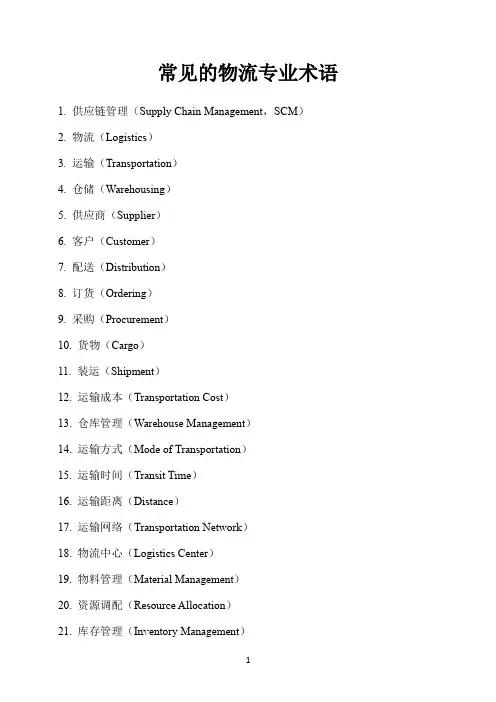
常见的物流专业术语1. 供应链管理(Supply Chain Management,SCM)2. 物流(Logistics)3. 运输(Transportation)4. 仓储(Warehousing)5. 供应商(Supplier)6. 客户(Customer)7. 配送(Distribution)8. 订货(Ordering)9. 采购(Procurement)10. 货物(Cargo)11. 装运(Shipment)12. 运输成本(Transportation Cost)13. 仓库管理(Warehouse Management)14. 运输方式(Mode of Transportation)15. 运输时间(Transit Time)16. 运输距离(Distance)17. 运输网络(Transportation Network)18. 物流中心(Logistics Center)19. 物料管理(Material Management)20. 资源调配(Resource Allocation)21. 库存管理(Inventory Management)22. 供应链协同(Supply Chain Collaboration)23. 海关(Customs)24. 清关(Customs Clearance)25. 国际贸易(International Trade)26. 出口(Export)27. 进口(Import)28. 海运(Ocean Freight)29. 空运(Air Freight)30. 铁路运输(Rail Transportation)31. 公路运输(Road Transportation)32. 仓储设施(Warehousing Facility)33. 仓储系统(Warehousing System)34. 包装(Packaging)35. 集装箱(Container)36. 货运代理(Freight Forwarder)37. 物流服务商(Logistics Service Provider)38. 运输安全(Transportation Security)39. 危险品运输(Hazardous Materials Transportation)40. 配送中心(Distribution Center)41. 装卸设备(Material Handling Equipment)42. 拣货(Picking)43. 装载(Loading)44. 卸货(Unloading)45. 中转(Transshipment)46. 运输保险(Transportation Insurance)47. 供应链可视化(Supply Chain Visibility)48. 物流效率(Logistics Efficiency)49. 物流成本(Logistics Cost)50. 逆物流(Reverse Logistics)51. 供应链优化(Supply Chain Optimization)52. 库存周转率(Inventory Turnover)53. 入库(Receiving)54. 出库(Shipping)55. 货运费用(Freight Charges)56. 运输路线(Transportation Route)57. 运输计划(Transportation Plan)58. 交付时间(Delivery Time)59. 运输管理系统(Transportation Management System,TMS)60. 仓储管理系统(Warehouse Management System,WMS)61. 托盘(Pallet)62. 货架(Rack)63. 供应商管理(Supplier Management)64. 货主(Shipper)65. 分销中心(Distribution Center)66. 订购点(Order Point)67. 定期订购(Regular Order)68. 经济订购数量(Economic Order Quantity,EOQ)69. 货运成本(Freight Cost)70. 运输效率(Transportation Efficiency)71. 供应链合作伙伴(Supply Chain Partner)72. 物流战略(Logistics Strategy)73. 货物跟踪(Cargo Tracking)74. 物流网络设计(Logistics Network Design)75. 全球物流(Global Logistics)76. 城市物流(Urban Logistics)77. 网络优化(Network Optimization)78. 成本控制(Cost Control)79. 风险管理(Risk Management)80. 总部仓库(Central Warehouse)81. 分布式仓库(Decentralized Warehouse)82. 跨境电商(Cross-border E-commerce)83. 供应商评估(Supplier Evaluation)84. 交货期(Delivery Date)85. 物流流程(Logistics Process)86. 物流组织(Logistics Organization)87. 物流规划(Logistics Planning)88. 跟踪系统(Tracking System)89. 订单处理(Order Processing)90. 门到门服务(Door-to-Door Service)91. 配送路线优化(Route Optimization)92. 冷链物流(Cold Chain Logistics)93. 单一窗口(Single Window)94. 联合运输(Intermodal Transportation)95. 快递(Express Delivery)96. 无人机配送(Drone Delivery)97. 末端配送(Last Mile Delivery)98. 供应链可持续性(Supply Chain Sustainability)99. 供应链风险(Supply Chain Risk)100. 货运容量(Freight Capacity)101. 系统集成(System Integration)102. 自动化仓库(Automated Warehouse)103. 运输需求管理(Transportation Demand Management)104. 配送计划(Distribution Plan)105. 订货周期(Order Cycle)106. 供应商协调(Supplier Coordination)107. 物流监控(Logistics Monitoring)108. 物流协同(Logistics Collaboration)109. 物流效益(Logistics Performance)110. 包装材料(Packaging Material)111. 拖车(Trailer)112. 仓储面积(Warehousing Space)113. 库存周转时间(Inventory Turnaround Time)114. 批次(Batch)115. 供应商评估指标(Supplier Evaluation Metrics)116. 运输分析(Transportation Analysis)117. 订单管理(Order Management)118. 运输优化(Transportation Optimization)119. 分销网络(Distribution Network)120. 多式联运(Multimodal Transportation)121. 物流策略(Logistics Strategy)122. 库存控制(Inventory Control)123. 物流信息系统(Logistics Information System)124. 运输监控(Transportation Monitoring)125. 物流效果评估(Logistics Performance Evaluation)126. 运输管理(Transportation Management)127. 收货确认(Receipt Confirmation)128. 配送时间窗口(Delivery Time Window)129. 物流外包(Logistics Outsourcing)130. 货运合同(Freight Contract)131. 运输文件(Transportation Documents)132. 物流安全(Logistics Security)133. 运输节点(Transportation Node)134. 物流地图(Logistics Map)135. 托运人(Consignor)136. 承运人(Carrier)137. 运输协议(Transportation Agreement)138. 物流审计(Logistics Audit)139. 运输成本分摊(Transportation Cost Allocation)140. 供应链可控性(Supply Chain Controllability)141. 仓储设备(Warehousing Equipment)142. 仓库布局(Warehouse Layout)143. 库位管理(Location Management)144. 入库管理(Receiving Management)145. 出库管理(Shipping Management)146. 发货通知(Shipment Notification)147. 配送费用(Distribution Costs)148. 运输分配(Transportation Allocation)149. 手工作业(Manual Operation)150. 电子商务物流(E-commerce Logistics)151. 航空货运(Air Cargo)152. 陆运(Land Transportation)153. 运输容量(Transportation Capacity)154. 环保物流(Green Logistics)155. 同城配送(Same-day Delivery)156. 订购量(Order Quantity)157. 装载率(Loading Rate)158. 卸载率(Unloading Rate)159. 损耗率(Loss Rate)160. 物流效能(Logistics Effectiveness)161. 供应链可靠性(Supply Chain Reliability)162. 物流合同(Logistics Contract)163. 仓库效率(Warehouse Efficiency)164. 计划运输(Planned Transportation)165. 非计划运输(Unplanned Transportation)166. 运输提单(Transportation Bill of Lading)167. 全程运输(Door-to-Door Transportation)168. 物流优化模型(Logistics Optimization Model)169. 仓储操作(Warehousing Operation)170. 运输过程(Transportation Process)171. 分销商(Distributor)172. 发货人(Consignor)173. 制造商(Manufacturer)174. 销售商(Retailer)175. 中转仓(Transit Warehouse)176. 集配中心(Consolidation and Distribution Center)177. 多渠道物流(Multichannel Logistics)178. 供应链整合(Supply Chain Integration)179. 物流服务水平(Logistics Service Level)180. 交货条件(Delivery Terms)181. 出口商(Exporter)182. 进口商(Importer)183. 港口(Port)184. 集装箱码头(Container Terminal)185. 干线运输(Trunk Transportation)186. 短途运输(Short-haul Transportation)187. 跨境物流(Cross-border Logistics)188. 拼箱(Less than Container Load,LCL)189. 整箱(Full Container Load,FCL)190. 物流外包商(Logistics Outsourcer)191. 物流执行系统(Logistics Execution System,LES)192. 物流规模化(Logistics Scaling)193. 货运管理(Freight Management)194. 物流数据分析(Logistics Data Analysis)195. 供应商协同计划(Supplier Collaboration Planning)196. 仓储容量规划(Warehousing Capacity Planning)197. 配送路线规划(Distribution Route Planning)198. 供应链网络优化(Supply Chain Network Optimization)199. 应急物流(Emergency Logistics)200. 满足率(Fill Rate)201. 物料需求计划(Material Requirements Planning,MRP)202. 运输订单(Transportation Order)203. 运输跟踪(Transportation Tracking)204. 物流成本分析(Logistics Cost Analysis)205. 运输报告(Transportation Report)206. 供应商评估体系(Supplier Evaluation System)207. 客户满意度(Customer Satisfaction)208. 采购管理(Procurement Management)209. 配送点(Delivery Point)210. 订购周期(Ordering Cycle)211. 缺货(Stockout)212. 外包物流(Outsourced Logistics)213. 物流效益评估(Logistics Performance Assessment)214. 境内物流(Domestic Logistics)215. 全球供应链(Global Supply Chain)216. 供应链整合技术(Supply Chain Integration Technology)217. 库存周转率指标(Inventory Turnover Ratio)218. 可追溯性(Traceability)219. 销售预测(Sales Forecast)220. 仓储费用(Warehousing Cost)221. 运输费率(Freight Rate)222. 物流信息共享(Logistics Information Sharing)223. 配送中心管理(Distribution Center Management)224. 入库检验(Receiving Inspection)225. 出库检验(Shipping Inspection)226. 货运监控(Cargo Monitoring)227. 物流执行(Logistics Execution)228. 物流路线规划(Logistics Route Planning)229. 城市配送(Urban Distribution)230. 物流模拟(Logistics Simulation)231. 系统优化(System Optimization)232. 运输效益评估(Transportation Efficiency Assessment)233. 运输需求预测(Transportation Demand Forecasting)234. 物流合作关系(Logistics Cooperation)235. 物流可靠性评估(Logistics Reliability Evaluation)236. 运输成本优化(Transportation Cost Optimization)237. 物流资金流转(Logistics Fund Flow)238. 供应链协同计划(Supply Chain Collaboration Planning)239. 仓库布局优化(Warehouse Layout Optimization)240. 运输容量规划(Transportation Capacity Planning)241. 物料流动(Material Flow)242. 运输效果分析(Transportation Effectiveness Analysis)243. 物流决策支持系统(Logistics Decision Support System)244. 供应链整合管理(Supply Chain Integration Management)245. 仓库操作规范(Warehouse Operation Specification)246. 订单处理时间(Order Processing Time)247. 运输效果评估(Transportation Effectiveness Evaluation)248. 物流网络优化(Logistics Network Optimization)249. 供应链风险管理(Supply Chain Risk Management)250. 货物追踪系统(Cargo Tracking System)251. 仓储容量规划(Warehousing Capacity Planning)252. 配送中心运作(Distribution Center Operation)253. 运输需求管理系统(Transportation Demand Management System)254. 运输过程监控(Transportation Process Monitoring)255. 物流信息共享平台(Logistics Information Sharing Platform)256. 库存周转率分析(Inventory Turnover Analysis)257. 批发物流(Wholesale Logistics)258. 城市配送中心(Urban Distribution Center)259. 货物跟踪技术(Cargo Tracking Technology)260. 物流供应商选择(Logistics Supplier Selection)261. 物流运营管理(Logistics Operations Management)262. 运输效能评估(Transportation Effectiveness Assessment)263. 物流执行管理(Logistics Execution Management)264. 物流路线优化(Logistics Route Optimization)265. 物流成本控制(Logistics Cost Control)266. 物流质量管理(Logistics Quality Management)267. 运输可行性分析(Transportation Feasibility Analysis)268. 物流人力资源管理(Logistics Human Resource Management)269. 物流合作模式(Logistics Cooperation Mode)270. 供应链服务水平(Supply Chain Service Level)271. 仓库容量规划(Warehousing Capacity Planning)272. 配送中心布局优化(Distribution Center Layout Optimization)273. 运输需求预测系统(Transportation Demand Forecasting System)274. 物流过程监控系统(Logistics Process Monitoring System)275. 供应链协同管理平台(Supply Chain Collaboration Management Platform)276. 仓储操作效率评估(Warehouse Operation Efficiency Assessment)277. 订单处理周期(Order Processing Cycle)278. 运输成本效益分析(Transportation Cost Benefit Analysis)279. 物流网络可达性(Logistics Network Accessibility)280. 供应链整合策略(Supply Chain Integration Strategy)281. 物料需求计划系统(Material Requirements Planning System)282. 运输订单管理系统(Transportation Order Management System)283. 运输跟踪技术(Transportation Tracking Technology)284. 物流成本分析系统(Logistics Cost Analysis System)285. 运输报告生成系统(Transportation Report Generation System)286. 供应商评估体系建立(Supplier Evaluation System Establishment)287. 客户满意度调查(Customer Satisfaction Survey)288. 采购管理系统(Procurement Management System)289. 配送点优化(Delivery Point Optimization)290. 订购周期缩短(Ordering Cycle Reduction)291. 运输安全管理(Transportation Security Management)292. 物流执行系统优化(Logistics Execution System Optimization)293. 物流路线规划系统(Logistics Route Planning System)294. 城市配送管理(Urban Distribution Management)295. 物流模拟系统(Logistics Simulation System)296. 系统优化方法(System Optimization Method)297. 运输效益评估指标(Transportation Effectiveness Evaluation Metrics)298. 物流协同计划系统(Logistics Collaboration Planning System)299. 仓库布局规划技术(Warehouse Layout Planning Technology)300. 运输容量规划系统(Transportation Capacity Planning System)这是一个包含常见物流专业术语的列表,覆盖了供应链管理、运输、仓储、供应商管理等多个方面。
物流管理(LogisticsManagement)
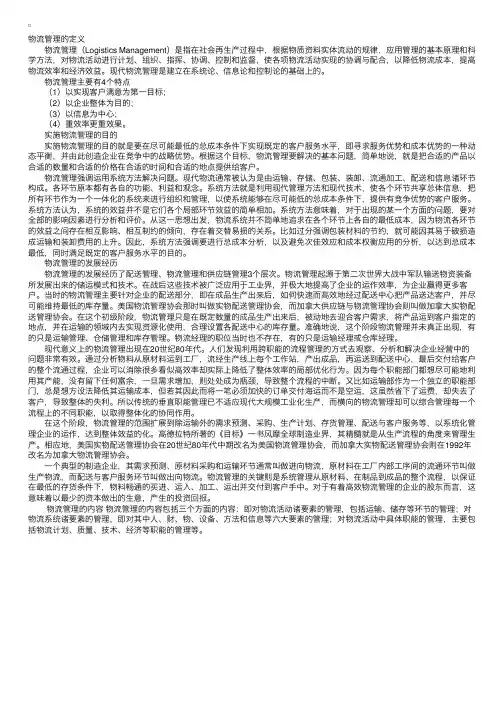
物流管理的定义 物流管理(Logistics Management)是指在社会再⽣产过程中,根据物质资料实体流动的规律,应⽤管理的基本原理和科学⽅法,对物流活动进⾏计划、组织、指挥、协调、控制和监督,使各项物流活动实现的协调与配合,以降低物流成本,提⾼物流效率和经济效益。
现代物流管理是建⽴在系统论、信息论和控制论的基础上的。
物流管理主要有4个特点 (1)以实现客户满意为第⼀⽬标; (2)以企业整体为⽬的; (3)以信息为中⼼; (4)重效率更重效果。
实施物流管理的⽬的 实施物流管理的⽬的就是要在尽可能最低的总成本条件下实现既定的客户服务⽔平,即寻求服务优势和成本优势的⼀种动态平衡,并由此创造企业在竞争中的战略优势。
根据这个⽬标,物流管理要解决的基本问题,简单地说,就是把合适的产品以合适的数量和合适的价格在合适的时间和合适的地点提供给客户。
物流管理强调运⽤系统⽅法解决问题。
现代物流通常被认为是由运输、存储、包装、装卸、流通加⼯、配送和信息诸环节构成。
各环节原本都有各⾃的功能、利益和观念。
系统⽅法就是利⽤现代管理⽅法和现代技术,使各个环节共享总体信息,把所有环节作为⼀个⼀体化的系统来进⾏组织和管理,以使系统能够在尽可能低的总成本条件下,提供有竞争优势的客户服务。
系统⽅法认为,系统的效益并不是它们各个局部环节效益的简单相加。
系统⽅法意味着,对于出现的某⼀个⽅⾯的问题,要对全部的影响因素进⾏分析和评价。
从这⼀思想出发,物流系统并不简单地追求在各个环节上各⾃的最低成本,因为物流各环节的效益之间存在相互影响、相互制约的倾向,存在着交替易损的关系。
⽐如过分强调包装材料的节约,就可能因其易于破损造成运输和装卸费⽤的上升。
因此,系统⽅法强调要进⾏总成本分析,以及避免次佳效应和成本权衡应⽤的分析,以达到总成本最低,同时满⾜既定的客户服务⽔平的⽬的。
物流管理的发展经历 物流管理的发展经历了配送管理、物流管理和供应链管理3个层次。
公司各种职位的英文表达
公司职位英文及缩写大全公司高层职位的英文缩写:???? CEO?? :?? Chief Executive Officer????? 首席执行官???? CFO?? : Chief Financial?? Officer????? 首席财务官???? COO : Chief Operated?? Officer???? 首席运营官???? CTO?? : Chief Technology Officer??? 首席技术官???? CIO??? : Chief Information Officer??? 首席信息官???? CRO : Chief Risk Officer?? 首席风险官CEO(Chief Executive Officer),即首席执行官,是美国人在20世纪60年代进行公司治理结构改革创新时的产物,它的出现在某种意义上代表着将原来董事会手中的一些决策权过渡到经营层手中。
在我国,CEO这个概念最早出现在一些网络企业中。
在那里,CEO往往是自封的,也很少有人去研究这一称谓对企业到底意味着什么。
但是,当“CEO”在中国叫得越来越响的时候,我们应该认识到,高层人员称谓的改变不是一件小事,设立CEO职位不应仅仅是对时尚的追赶。
CFO(Chief Financial Officer)意指公司首席财政官或财务总监,是现代公司中最重要、最有价值的顶尖管理职位之一,是掌握着企业的神经系统(财务信息)和血液系统(现金资源)灵魂人物。
做一名成功的CFO需要具备丰富的金融理论知识和实务经验。
公司理财与金融市场交互、项目估价、风险管理、产品研发、战略规划、企业核心竞争力的识别与建立以及洞悉信息技术及电子商务对企业的冲击等自然都是CFO职责范围内的事。
在一个大型公司运作中,CFO是一个穿插在金融市场操作和公司内部财务管理之间的角色。
担当CFO的人才大多是拥有多年在金融市场驰骋经验的人。
在美国,优秀的CFO常常在华尔街做过成功的基金经理人。
物流管理 英语
物流管理英语Logistics ManagementLogistics management is a process of planning, implementing and controlling the movement and storage of goods and services from their origin to their final destination. It is an essential part of supply chain management that plays a crucial role in ensuring efficient and effective distribution of products and services.The logistics management process involves several activities, including transportation, warehousing, inventory management, and material handling. These activities are coordinated to ensure that products are delivered on time, in the right quantity, and at the right cost.TransportationTransportation is a critical component of logistics management. It involves moving products from one location to another through various modes of transportation, including air, land, and sea. Different factors such as distance, time, cost, and product type influence the choice of transportation mode.Air transport is the fastest mode of transportation, and it is usually used for time-sensitive products such as medical supplies, perishable goods, and high-value products. Land transportation, including road and rail, is mostly used for moving products within a specific region or country. On the other hand, sea transportation is mainly used for transporting products across oceans. It is cost-effective but relatively slower than other modes of transportation.WarehousingWarehousing is the storage of products before they are transported to their final destination. Warehouses are used to store products for different reasons, including seasonal demand, economic order quantity, and better delivery efficiency. Efficient warehouse management ensures that products are stored in optimal conditions, and they are easy to locate and retrieve.Inventory ManagementInventory management involves monitoring the quantity, location, and movement of products in the supply chain. It ensures that products are always available when needed, and there are no stockouts. The inventory management process involves forecasting demand, ordering products, receiving and storing products, and managing inventory levels.Material HandlingMaterial handling involves moving products within the warehouse or distribution center. It includes picking products, packing products, and loading and unloading products from transportation vehicles. Efficient material handling is essential in ensuring that products are moved quickly and without damage.ConclusionLogistics management plays a significant role in the success of any business. It involves coordinating different activities, including transportation, warehousing, inventory management, and material handling, to ensure that products are delivered on time, in the right quantity, and at theright cost. Efficient logistics management leads to improved customer satisfaction, reduced costs, and increasedprofitability, which are essential for the long-term success of any organization.。
物流管理专用英语
物流管理专用英语 Document number:PBGCG-0857-BTDO-0089-PTT1998物流管理专用英语这里是物流管理33个专用英语,希望能给大家带来便利!1物品Article经济活动中涉及到实体流动的物质资料。
2物流Logistics物品从供应地向接收地的实体流动过程。
根据实际需要,将运输、储存、装卸、搬运、包装、流通加工、配送、信息处理等基本功能实施的有机结合。
3物流活动Logistics?activity物流诸功能的实施与管理过程。
4物流作业Logistics?operation实现物流功能时所进行的具体*作活动。
5物流模数Logistics?modulus物流设施与设备的尺寸基准。
6物流技术Logistics?technology物流活动中所采用的自然科学与社会科学方面的理论、方法,以及设? 施、设备、装置与工艺的总称。
7物流成本Logistics?cost物流活动中所消耗的物化劳动和活劳动的货币表现。
8物流管理Logistics?management为了以最低的物流成本达到用户所满意的服务水平,对物流活动进行的计划、组织、协调与控制。
9物流中心Logistics?center从事物流活动的场所或组织。
应基本符合下列要求:(1)主要面向社会服务;(2)物流功能健全;(3)完善的信息网络;(4)辐射范围大;(5)少品种、大批量;(6)存储、吞吐能力强;(7)物流业务统一经营、管理。
10物流网络Logistics?network物流过程中相互联系的组织与设施的集合。
11物流信息Logistics?information反映物流各种活动内容的知识、资料、图象、数据、文件的总称。
12物流企业Logistics?enterprise从事物流活动的经济组织。
13物流单证Logistics?document s物流过程中使用的所有单据、票据、凭证的总称。
14物流联盟Logistics?alliance两个或两个以上的经济组织为实现特定的物流目标而采取的长期联合与合作。
物流管理与工程的英语专业词汇
物流管理与工程的英语专业词汇Logistics management is a crucial aspect of many industries, involving the planning, implementing, and controlling the movement and storage of goods. 物流管理是许多行业的重要组成部分,涉及货物的运输、存储的规划、实施和控制。
In order to effectively manage logistics processes, professionals in this field need to be familiar with a range of specialized vocabulary. 为了有效地管理物流流程,这个领域的专业人员需要熟悉各种专业词汇。
Some key terms that are commonly used in logistics and engineering include supply chain management, inventory control, and transportation planning. 一些在物流和工程中常用的关键词包括供应链管理、库存控制和运输规划。
Supply chain management refers to the coordination of processes involved in the production and distribution of goods. 供应链管理是指涉及货物生产和分配的过程的协调。
Inventory control involves maintaining optimal levels of stock to meet customer demand while minimizing costs. 库存控制涉及保持适当水平的库存,以满足客户需求同时最小化成本。
- 1、下载文档前请自行甄别文档内容的完整性,平台不提供额外的编辑、内容补充、找答案等附加服务。
- 2、"仅部分预览"的文档,不可在线预览部分如存在完整性等问题,可反馈申请退款(可完整预览的文档不适用该条件!)。
- 3、如文档侵犯您的权益,请联系客服反馈,我们会尽快为您处理(人工客服工作时间:9:00-18:30)。
RESUME
Strength
·Logistics expert in planning, purchasing and distribution.
·My special knowledge in logistics field covers logistics planning, logistics system development, warehousing, transportation, etc.
·Supplying chain management, investment project handling, ISO9000 certification, import and export business.
·based on long-term management experience, be able to lead a project team to settle any difficulties with efficient communication and sincere cooperation.
Personal
Name: ××××Gender:Female Date of Birth:August 23th, 1980
Martial Status:Married Email Address: ××××
Tel:(010) ××××Mobile Phone: ××××
Experience
07/×××× - 12/××××XXXX China Logistics Manager
·Monitoring and improving national supply chain performance through designing, implementing and analyzing KPI (from totally new design to implementation throughout the company, including inventory turnover, backorder ratio, supply availability, sales forecast reliability, warehouse utilization and other related measurements.
·Taking a lead in countrywide inventory optimization project.
·Taking a lead in T&A products purchase, inventory, and distribution planning and logistics operations implementation.
·Cooperating with The Third Party Logistics Service provider to continuously improve the warehousing and transport efficiency.
01/××××- 07/××××XX Shanghai Manager of Logistics
·Established purchase, production and sales logistics processes based IT system.
·In charge of daily logistics operation.
·In charge of forwarders management and bonded warehousing management.
·Struggled in optimize the inventory on the supply chain.
·Cooperated with production dept. to made MRS and BOM.
08/×××× - 01/××××XXX Co. Beijing Logistics Supervisor
·In charge of import contracts and orders management.
·In charge of bonded warehousing management.
·Supervised the performance of freight forwarders and carriers based on cost, delivery and service quality.
·In charge of international and domestic purchasing and transportation.
·Processed all the customs-office-related issues.
Education
07/××××Beijing University xxx MBA
01/09/××××xx Trade Institute International Trade Bachelor
Language: Be able to communicate efficiently with colleagues and customers in fluent English, whatever in Written, Spoken, Reading or Listening.
Computer: Computer software expert in Excel and Access. Familiar with systems like BPCS, SCALA and related.。
